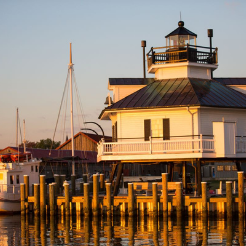
Three recently released economic impact studies point to what we already know – tourism is a powerful economic driver in Talbot County.
“We participate in an annual survey with other Destination Marketing Organizations around the state,” says Cassandra Vanhooser, director of economic development and tourism for Talbot County. “The data used for that study comes directly from the comptroller’s office and includes sales tax collections in the categories most impacted by visitors. We use this information to assess trends and gauge the overall health of the industry.”
 The economic impact studies conducted by the Chesapeake Bay Maritime Museum and the Waterfowl Festival turn the spotlight on specific organizations that attract visitors to Talbot County. A statewide economic contribution analysis shows the powerful impact of Maryland’s statewide program to develop heritage-related attractions.
The economic impact studies conducted by the Chesapeake Bay Maritime Museum and the Waterfowl Festival turn the spotlight on specific organizations that attract visitors to Talbot County. A statewide economic contribution analysis shows the powerful impact of Maryland’s statewide program to develop heritage-related attractions.
“This information helps us narrow the focus and look at organizations that we know are bringing people to the county,” Vanhooser explains. “We know they are important to the economy here, but the information from these studies quantifies their importance.”
Economic impact studies such as these take many months to complete, and they can be costly. Still, it’s important to gather this information every few years to assess an organization’s ongoing importance. A summary of the findings includes the following.
Waterfowl Festival Economic and Cultural Impact Study
- A study conducted by Rockport Analytics found that the Waterfowl Festival drew more than 15,000 people to Easton in 2019, generating a total economic impact of $2.6 million.
- Visitors spent an average of $421 during their visit. Analysis shows that 74 cents from each dollar spent during the festival remained in Talbot County.
- Of the people attending the festival, 6,800 traveled more than 50 miles and 1,700 visitors traveled more than 100 miles.
- The report also shows that 6 out of 10 visitors stay overnight with 57% of staying in Easton.
Chesapeake Bay Maritime Museum Economic and Community Impact Study
- According to an economic impact study of Fiscal Year 2020, also by Rockport Analytics, more than 84,000 people visited CBMM in 2019 and spent $11.6 million.
- Almost half of the visitors came from out-of-state and 53% stayed overnight. Most of the visitors had been to the museum before and entered on a general admission ticket.
- On average visitors spent $220 per day in Talbot County during their visit.
- CBMM added $10.3 million to the Talbot County economy and contributed to 259 full- and part-time jobs.
- Wages paid to employees directly supported by CBMM-initiated visitors and operations spending in Talbot County reached nearly $6.3 million.
Maryland Heritage Areas Economic Contribution Analysis
- A recently released study conducted by Parker Phillips shows that Heritage Area visitor spending contributed a total of $2.4 billion to the state’s economy.
- In Fiscal Year 2019, Maryland’s Heritage Areas and related tourism contributed an estimated $319.8 million in state and local taxes through local spending (operational, grant making, heritage tourism), as well as direct and indirect support of jobs.
- The program supports and sustains a combined total of 33,815 full-time and part-time jobs throughout the state.
- Talbot County is one of four counties in the Stories of the Chesapeake Heritage Area.